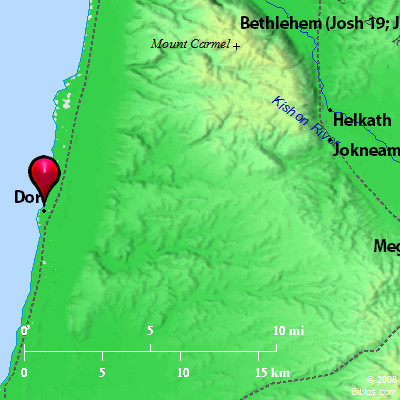Atlas  Dor and surrounding area Maps Created using Biblemapper 3.0 Additional data from OpenBible.info Occurrences Joshua 12:23 the king of Dor in the height of Dor, one; the king of Goiim in Gilgal, one;Joshua 17:11 Manasseh had three heights in Issachar, in Asher Beth Shean and its towns, and Ibleam and its towns, and the inhabitants of Dor and its towns, and the inhabitants of Endor and its towns, and the inhabitants of Taanach and its towns, and the inhabitants of Megiddo and its towns. Judges 1:27 Manasseh did not drive out the inhabitants of Beth Shean and its towns, nor of Taanach and its towns, nor the inhabitants of Dor and its towns, nor the inhabitants of Ibleam and its towns, nor the inhabitants of Megiddo and its towns; but the Canaanites would dwell in that land. 1 Chronicles 7:29 and by the borders of the children of Manasseh, Beth Shean and its towns, Taanach and its towns, Megiddo and its towns, Dor and its towns. In these lived the children of Joseph the son of Israel. Encyclopedia DOR; DORAdor, do'-ra (do'r, dor, "habitation," "circle"; Dor; Josephus, Dora; modern TanTurah): A town of the coast of Palestine, South of Carmel (Apion, II, 10; Vita, 8), about 8 miles North of Caesarea. It was occupied in the earliest times by the Canaanites and probably belonged to Phoenicia, tradition saying that it was a Sidonian colony. It furnished an abundance of the shell-fish so valuable for the manufacture of the Tyrian purple, and this would have led the Phoenicians to occupy the site. In the 12th century B.C., the region was occupied by the northern people who raided the whole Syrian coast and Egypt. They were driven back by the Egyptians, but renewed the attack, and the weakness of Egypt in the middle of the century enabled them to settle in the coast region South of Carmel; a tribe of them occupied Dor, and others the territory to the limits of the desert of Sinai, and became the Philistine people so well known by their contests with the Hebrews. Naphoth-dor, "the heights of Dor," may be the slopes of Carmel inland from TanTurah. Dor fell within the territory assigned to Manasseh (Joshua 17:11; compare Ant, V, i, 22). It was the seat of a king who possessed other towns on the heights back of the coast. He was one of the allies of Jabin of Hazor in the conflict with Joshua (Joshua 11:2) and was conquered by him (Joshua 12:23), but Dor was not occupied by the Israelites (Joshua 17:11 Judges 1:27). DOR, a royal city of the Canaanites, now Tantura, 7 ms. north of Cesarea on the seacoast, 60 ms. n. by w. of Jerusalem. Strong's Hebrew H1756: Dora city in Palestine |



